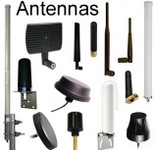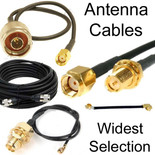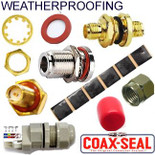Antennas, Antenna Cables, Wireless Products: Technical Articles
LoRa Antennas to Extend the Range of LoRaWAN Devices
Antennas To Extend Range of LoRaWAN
- All of our LoRa antennas are compatible with all Nova Labs miners / devices in the US and Europe.
- See our Nova(Helium) accessory items directory: Antennas, cables & accessories for range-extension of Helium miners, including Bobcat miners, SenseCAP miners and all other Helium LongFi miners.
Nova(Helium) / LoRa antennas are antennas that can be used to support the Long Range wireless networking technology known as Helium and also known as LoRa.
LoRa Antenna Frequencies
LoRa uses frequencies in the unlicensed Industrial Scientific and Medical (ISM) frequency bands. Because they are unlicensed they are very cost-effective to utilize and the frequencies are chosen also have good performance for distance transmission and penetration of buildings or obstructions. The key frequencies used are:
- 915 MHz - This is also known as the 33-centimeter band (the wavelength of this frequency). It spans 902 Mhz to 928 MHz. 915 Mhz is the center frequency. 915 is used license-free for LoRa in the United States and shares its use with Amateur Radio. It is also a band used by GSM.
- 868 MHz - 868 MHz is used for LoRa networking in Europe; it is also license-free and has similar characteristics and performance to the 915 frequency band. Most LoRa IoT antennas will be dual-band and therefore able to be used in the US and Europe.
Types of LoRa antennas

[A] Dipole LoRa antennas: This is a basic and highly versatile omnidirectional antenna design that can be screwed onto devices as an external antenna, usually via a SMA connector. Many of these antennas have an articulating knuckle so that they can be adjusted for the best coverage. Dipole antennas are simply two wires (which are the resonant elements), that are connected at their midpoint by a feedline.
[B] Yagi antennas for LoRa networking: Yagi antennas are highly directional antennas that are extremely effective at transmitting data over long distances. They are made up of a set of parasitic elements aligned in front of and behind a single driven element that is connected to the feedline. The arrangement of the parasitic elements in the Yagi design gives the antenna its high-gain directional performance.
[C] Puck antennas for LoRa: Puck antennas are omnidirectional antennas designed for through-hole mounting on vehicle roofs and other surfaces. They are named because they resemble a hockey puck.
[D] Quarter wave whip 915 MHz LoRa antennas: These full, half, or quarter-wavelength antennas are designed to be mounted on vehicles or attached directly to devices. They provide omnidirectional coverage.
[E] Collinear LoRa antennas: Collinear arrays are composed of multiple antenna elements that are vertically stacked for a net increase in gain. These powerful outdoor antennas are mounted at height for long-range connectivity.
[F] Stub LoRa antennas: These are short, helical antennas that are compressed into small units. The coiling of the antenna element (usually a quarter wavelength) reduces the overall length of the antenna making it compact and portable.
External antennas for Nova Labs Miners / Hotspots.
The coverage achieved by a Nova(Helium) Hotspot is critical to its performance in earning HNT rewards. It is therefore in the interests of Miner owners to achieve the best coverage possible by upgrading the Nova(Helium) Hotspot antenna to an external antenna with higher gain. The right antenna can pay for itself within days of purchase as it achieves connection to more witness hotspots and the Miner it is connected to will have better PoC performance.
Nova(Helium) antennas are LoRa antennas, and by using an outdoor LoRa antenna with enhanced performance, Helium users are finding that the Miners can become more profitable which is important given the significant upfront costs. Data Alliance carries LoRa antennas for both the 868 and 915 frequencies.
In areas with a high density of hotspots an outdoor LoRa antenna that is connected to the Miner can produce a significant uplift in earnings. An external omnidirectional LoRa antenna can also have its position adjusted to optimize its range. Fiberglass collinear arrays mounted at height, and magnetic-mount whip LoRa antennas are popular solutions.
RoHS compliant LoRa antennas

Our range of high-quality LoRa antennas is manufactured to the highest standards with parts of excellent provenance. All of our range of LoRa antennas are compliant with the Restriction of Hazardous Substances (RoHS) directive, a European Union law that limits the use of certain hazardous materials in Electrical and Electronic Equipment (EEE).
These antennas also comply with domestic and international conflict mineral legislation including Section 1502 of the Dodd-Frank Act and the Conflict Minerals Regulation. Compliant items do not use Gold, Tin, Tantalum, or Tungsten that is sourced from areas associated with conflict or forced labor.
The importance of LoRa antennas
In the US, the use of the 433 MHz frequency band is restricted by FCC regulations, necessitating the use of the 915 MHz frequency for LoRa networking. This sub-gigahertz frequency supports long-range connectivity that is characteristic of LoRa networking. The 915 MHz antennas have the advantage of being higher gain. The 433 MHz frequency band is used for LoRa in Asia.
Signal transmission using LoRa Signal propagation for LoRa is primarily reliant on line of sight. This means that 915 MHz LoRa antennas and repeaters are usually mounted at a height so that they are above obstructions like buildings or hills. A 915 MHz antenna's signal is able to travel around 75 percent of the distance of a 433 MHz antenna with equivalent transmitting power. LoRa signals are able to penetrate buildings and vegetation also.
Characteristics of LoRa Wireless Area Networking
LoRa uses spread spectrum modulation for efficient low energy data transfer over distance.
Chirp Spread Spectrum (CSS) is adapted for use in LoRa. In CSS the bandwidth of the transmitted signal is increased, compensating for any deterioration in signal to noise ratio. The data rate is also regulated to enhance the signal coverage or power consumption where needed.
This approach makes LoRa transmission resilient against multipath fading while keeping power consumption low, an advantage in urban settings. However, data rates are critical to achieving the low power, wide-area performance of LoRa, with data rates needing to be kept low. Transmitted data is broken into 'chirps' which are transmitted or 'spread' with varying rate and frequency. The chirp rate used is called the Spreading Factor (SF) and determines the most efficient use of the network.
Key features of LoRa connectivity include:
- Scalability of frequency and bandwidth.
- Long-range connectivity
- Transmitters in LoRa networks have low power output.
- LoRa networks have resilience against in-band and out-band interference as well as fading and Doppler shift
- Ability to combine individual connections to create high-capacity mesh networks
- A decentralized structure that supports localization via networked nodes
The LoRaWAN network protocol
LoRa has a point to multipoint system architecture. Its architecture, control (frequencies used and data rates), and communication within deployed networks are specified in its proprietary networking protocol.
Devices that are part of a LoRa network only transmit when they have data to send. Their transmissions are then relayed through a hierarchy of nodes within the mesh network they are part of.
LoRa networking can be limited in that it lacks a system for acknowledging that data has been received. This is addressed in LoRa based networks like Nova Labs(Helium Network) which is described below. Coverage of nodes within LoRa networks can be as much as 15 kilometers (10 miles).
Nodes or devices participating within a LoRa network are one of three types:
- Class A nodes will broadcast their data asynchronously or whenever needed. Without data to transmit they remain inactive, keeping their energy consumption low.
- Class B will not communicate with other nodes in the network at regular intervals. The receiving nodes are battery or mains-powered and therefore capable of listening at scheduled intervals for transmissions.
- Class C devices or nodes are always on. These active nodes can receive a signal transmission at any time. They usually require mains power.
LoRa antennas for IoT
LoRa is proving itself to be a key contender for the technology that underpins massive Internet of Things expansion. Currently, IoT networking is heterogenous, relying on cellular, WiFi, and other mesh network technologies. Though effective, high throughput networking like WiFi or cellular is expensive and not well-tailored to the requirements of IoT devices. LoRa on the other hand is designed to support sensor-based systems which send minute data packets at irregular intervals. Most cellular data systems can match the coverage and range of LoRa, though they tend to be more expensive to maintain as compared to LoRa systems. The reason for this is that LoRa demands less from the underlying network, given its significantly lower use of bandwidth. This makes cellular network subscriptions many times more expensive than LoRa.
The long-distance coverage of LoRa supports IoT devices in remote locations where mains power is unavailable. As LoRa is low power, it can be used with battery-powered devices that can last up to 10 years in the field.
Semtech licenses a LoRa compliant chipset that can be integrated with IoT devices so that they can be connected. The LoRa Alliance consists of more than 500 companies who work on standardizing LoRa interoperability and contribute to a growing marketplace of LoRa based solutions.
Applications that use LoRa antennas
LoRa has found use in a wide range of applications though it is most preferred in IoT Internet of Things devices that:
- Have no access to electricity
- Do not require instant feedback
- Are too many to get a costly cellular subscription for
- Are inconvenient or impossible to physical access
Given its long range and low power capacities endpoint devices can be deployed in all manner of outdoor and indoor facilities. Applications include devices in smart cities, smart logistics, supply chain, smart homes, smart metering, and smart agriculture.
LoRa applications are so widespread and diverse that the technology has grown to set the standard for LP-WAN connectivity It is beginning to move beyond IoT/ M2M competitor technologies like SigFox and NB-IOT (comparison below).
Commercial sectors that currently use LoRa technology for IoT include
- Environmental surveillance: Sensor-based IoT devices can measure key environmental factors like air quality, rainfall, and ground or water temperature. Battery-powered scientific stations can relay their data over long distances to a remote hub.
- Agriculture: Again the long-distance nature of LoRa networking means that large territories of agricultural land can be monitored for useful data points including plant growth, movements of cattle, irrigation, or egg production.
- Pet tracking: LoRa networks that have reliable coverage can be used for non-GPS geolocation or tracking of pets that wear a device as they move among nodes in the mesh network.
- Utility infrastructure: Utility meters can be monitored remotely with meters transmitting their readings using LoRa.
- Inventory tracking: Valuable assets can be secured and monitored using a LoRa based network.
SigFox is a long-range, low energy networking alternative to LoRa
915 MHz SigFox antennas
These 915 MHz antennas are also suitable for supporting SigFox connectivity as it uses the same frequency as LoRa.
SigFox LP-WAN technology uses differential binary phase-shift keying (DBPSK) and the Gaussian frequency-shift keying (GFSK) rather than the CSS used by LoRa to achieve sub-gigahertz connectivity. It has a data rate of 100 bits per second with limited bi-directional connectivity. SigFox networks have a one-hop star topology. They are highly reliant on performance 915 MHz antennas for optimal functioning.
Key differences between LoRa and SigFox include:
- SigFox functions as a network operator, providing the technology on a subscription basis that companies will use to create their networks.
- SigFox networks tend to be simple star networks compared to the expansive mesh networking of LoRa. SigFox networks tend to have very limited bidirectional communication between participating nodes.
- SigFox provides greater coverage than LoRa and is available in 60 countries.
- The CSS of LoRa uses much more bandwidth than SigFox.
- SigFox uses infrequent transmissions and has longer battery life.
- SigFox radio modules and chipsets are cheaper.
LoRa versus NB-IoT
The Narrow Band Internet of Things ( NB-IoT) is a notable alternative to LoRa for IoT networking. It uses licensed LTE technology developed and standardized by the Third Generation Partnership Project (3GPP).
NB-IoT differs from LoRa because it uses technology for its networking. NB-IoT operates on a licensed part of the spectrum whereas LoRa uses unlicensed ISM bands. LoRa consumes less energy and bandwidth and low latency in comparison. Being licensed makes NB-IoT more expensive and higher energy, but NB-IoT is more secure.
915 MHz antennas can also be used for Amateur Radio.
Amateur radio users can use the 33-centimeter band for Amateur Television (ATV), and radio communications like FM, CW, and SSB. It is popular because it has performance and propagation qualities that are similar to the 70-centimeter band. Enthusiasts are advised that the band may be subject to interference from devices that use it as an ISM band. These external 915 MHz antennas can be used with radios, repeaters, and amplifiers.
In conclusion
The 915 MHZ frequency band has become standard for widely available low power, wide-area networking technologies, and in the US is standard for LoRA and other sub-gigahertz wireless technologies. Its cost-effectiveness and coverage make it able to provide the support necessary for a burgeoning range of IoT applications.
LoRa is a rapidly scalable technology for IoT networking that has demonstrated consistent performance and utility in comparison to its nearest competitors.
LEARN MORE:









